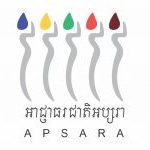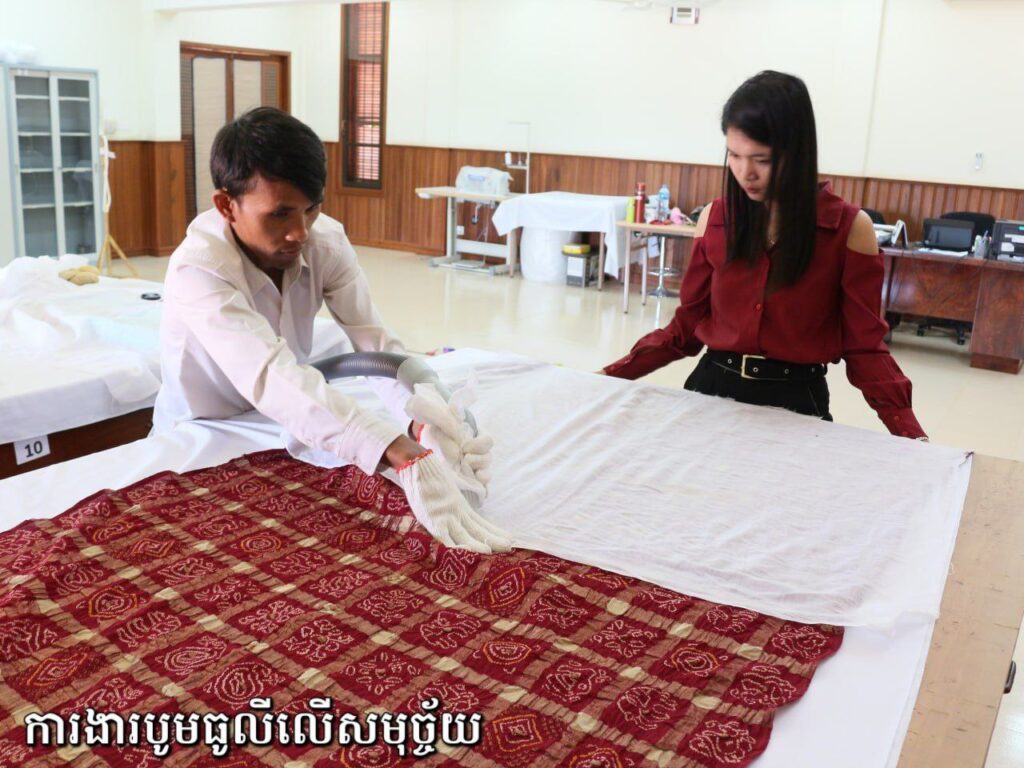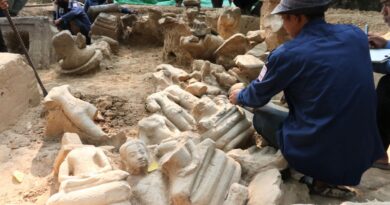សារមន្ទីរវាយនភណ្ឌប្រពៃណីអាស៊ីនៅក្នុងខេត្តសៀមរាប អាចជាសារមន្ទីរដំបូងគេនៃព្រះរាជាណាចក្រកម្ពុជា ដែលមានដាក់តាំងបង្ហាញរបស់ប្រើប្រាស់ផលិតចេញពីសរសៃសូត្រ សរសៃកប្បាស សរសៃអំបោះ សរសៃគ សំបកឈើ រោមសត្វ តាមបែបប្រពៃណីផ្សេងៗគ្នា រួមទាំងជាសម្លៀកបំពាក់សហសម័យ មកពីបណ្តាប្រទេសចំនួន៦ ដែលរស់នៅតាមដងទន្លេមេគង្គ និងទន្លេគង្គារ។ ផលិតផលធ្វើអំពីសូត្រ អំបោះរុក្ខជាតិ និងរោមសត្វ ដែលគេយកមកតាំងបង្ហាញទាំងនោះ មានដូចជាសម្លៀកបំពាក់ មួក ស្រោមដៃ-ជើង កន្សែង ឆ្នួត និងវត្ថុធាតុដើមជាច្រើនទៀត រួមទាំងឧបករណ៍តម្បាញផង។
ក្រុមអ្នកជំនាញរបស់សារមន្ទីរ បានយកចិត្តទុកដាក់ប្រើប្រាស់បច្ចេកទេសយ៉ាងត្រឹមត្រូវ ដើម្បីថែទាំ និងការពារអភិរក្សសមុច្ច័យទាំងនោះ មិនឱ្យខូចខាតទៅតាមអាយុកាល និងពេលវេលាឡើយ បើទោះបីជាសមុច្ច័យទាំងនោះ មានអាយុកាលច្រើនឆ្នាំមកហើយក៏ដោយ។
នាយកស្តីទីនៃសារមន្ទីរវាយនភណ្ឌប្រពៃណីអាស៊ីលោក សែន គឹមស៊ុនឱ្យដឹងថា ផលិតផលធ្វើពីសូត្រ អំបោះរុក្ខជាតិ និងរោមសត្វទាំងអស់ ដែលមានតាំងបង្ហាញនៅក្នុងសារមន្ទីរមិនមែនតាំងសម្រាប់តែ១ឆ្នាំ ឬ២ឆ្នាំ ហើយពេលវាខូចត្រូវបោះចោលនោះទេ គឺក្រុមអ្នកជំនាញមានបច្ចេកទេសត្រឹមត្រូវ ក្នុងការថែរក្សារបស់ទាំងនោះឱ្យស្ថិតនៅបានយូរអង្វែងតទៅទៀតតាមដែលអាចធ្វើបាន។ លោក សែន គឹមស៊ុន មានប្រសាសន៍ទៀតថា សារមន្ទីរវាយនភណ្ឌប្រពៃណីអាស៊ីមានគោលការណ៍ពីរក្នុងការអភិរក្ស ផលិតផលសូត្រទាំងនោះដើម្បីរក្សាទុកឱ្យបានយូរអង្វែង គឺត្រូវការអភិរក្សយ៉ាងយកចិត្តទុកដាក់នៅមុនពេលខូចខាត ដោយគិតពីបច្ចេកទេស តាំងតែពីការរៀបចំដាក់តាំងដើម្បីកុំឱ្យប៉ះពាល់ដល់សមុច្ច័យ ដូចជាការព្យួរ និងដាក់ក្នុងទូជៀសវាងសមុច្ច័យទាំងនោះកុំឱ្យទៅប៉ះផ្ទាល់ជាមួយដែក ឬឈើដែលអាចនាំឱ្យមេឬសត្វល្អិតស៊ី និងធ្វើឱ្យកកិតជាដើម។ រៀងរាល់ព្រឹកត្រូវបើកបង្អូច និងទ្វារក្នុងរយៈពេលខ្លី កុំឱ្យមានក្លិនផ្អួរនៅក្នុងសាលពិព័រណ៌នីមួយៗ សម្អាតកម្រាល និងជើងទម្រជាប្រចាំ ផ្លាស់ប្តូរទីតាំងជើងទម្រ ដើម្បីសម្អាតជៀសវាងមានធូលីកុំឱ្យមានសត្វល្អិត ឬធូលីតោងជាប់វត្ថុទាំងនោះអាចនាំឱ្យមានបញ្ហាដល់សមុច្ច័យបាន។ ដាក់ថ្នាំសម្លាប់សត្វល្អិតនៅតាមជ្រុង និងទ្វារនៃសាលពិព័រណ៍និងដាក់របាំងការពារសត្វកណ្តុរ។ ចំណុចយកចិត្តទុកដាក់មួយទៀត គឺនៅពេលដែលសមុច្ច័យខូចខាត គឺត្រូវជួសជុលភ្លាមៗទៅតាមបច្ចេកទេស ដែលសារមន្ទីរវាយនភណ្ឌប្រពៃណីអាស៊ី ធ្លាប់ទទួលបានការបង្ហាត់បង្រៀនពីអ្នកជំនាញឱ្យចេះពីវិធីជួសជុល និងសង្រ្គោះផលិតផលទាំងនោះឱ្យរួចផុតពីហានិភ័យ។
លោក សែន គឹមស៊ុន បានឱ្យដឹងទៀតថា ទាក់ទងនិងសាលសម្រាប់ដាក់តាំងពិព័ណ៌ទៀតសោត ក៏ត្រូវគ្រប់គ្រងពន្លឺអំពូលភ្លើងឱ្យបានសមស្រប ជៀសវាងការហើរពណ៌របស់ផលិតផល។ ម្យ៉ាងវិញទៀត ការកំណត់សីតុណ្ហភាពរឹតតែសំខាន់ ដោយនៅគ្រប់សាលពិព័រណ៍ គឺទាមទារឱ្យមានឧបករណ៍សម្រាប់វាស់សីតុណ្ហភាពជាប្រចាំ សម្រាប់ពិនិត្យតាមដាន កំណត់កម្តៅត្រឹម៣០អង្សា និងសំណើម៦៥ភាគរយ។
មន្ត្រីនៃសារមន្ទីរវាយនភណ្ឌប្រពៃណីអាស៊ី ឱ្យដឹងទៀតថា ដើម្បីសុវត្ថិភាពក្នុងការថែរក្សាផលិតផលទាំងនោះឱ្យបានយូរអង្វែង សារមន្ទីរក៏មានដាក់បម្រាមសម្រាប់ភ្ញៀវដែលចូលមកទស្សនាទាំងឡាយ ហាមយកចំណីអាហារ និងភេសជ្ជៈចូល ហាមប៉ះ ឬស្ទាបជាដើម ដែលអាចនឹងនាំមកនូវហានិភ័យផ្សេងៗអាច ដល់សមុច្ច័យ៕
អត្ថបទ: យី សុថា
រូបភាព: ភោគ ជា, សារមន្ទីរវាយនភ័ណ្ឌប្រពៃណីអាស៊ី
The MGC Asian Traditional Textiles Museum in Siem Reap may be the first museum in the Kingdom of Cambodia to display a wide range of items made from silk, cotton, linen, silk, bark, and wool, as well as contemporary clothing. From six countries living along the Mekong and Ganges rivers. The silk, cotton, and animal products on display include clothing, hats, gloves, socks, scarves, and many other materials, as well as weaving tools.
The museum’s experts take care to use the right techniques to maintain and preserve those collections from being damaged, even though those collections are years old.
Sen Kimsun, acting director of the MGC Asian Traditional Textiles Museum, said that all the silk, cotton, and animal products on display in the museum are not for one or two years and should be discarded when damaged. Experts have the right technique to maintain them for as long as possible. Mr. Sen Kimsun said that we have two principles to preserve those silk products to preserve them for a long time: they need to be carefully preserved before being damaged. In order not to affect the objects such as hanging and putting in the display cabinet, avoid those objects do not come into direct contact with metal or wood, which can lead to the insects eating and cause friction and so on. Every morning, we open the windows and doors for a short time so that there is no smell in each gallery, clean the floor and the pedestal regularly, and change the position of the pedestal to clean and avoid dust, insects or dust cling leading to problems with the collections. Put pesticides in the corners and doors of the gallery and put up a rat-proof barrier. Another point of concern is that when a collection is damaged, it must be repaired immediately according to the techniques that museum experts have trained to know how to repair and save those products from risk.
Mr. Sen Kimsun said that in the exhibition hall, it is also necessary to control the lighting properly to avoid changing the product’s color. On the other hand, setting the temperature is even more important, as all galleries require regular temperature tools to monitor, setting the temperature to 30 degrees and the humidity to 65 percent.
He added that for the safety of the products for a long time, the museum also has a ban on food, and beverages, and no touch, which may bring various risks that can lead to the collections.
Article: Yi Sotha
Photos: Phok Chea/MGC Asian Traditional Textiles Museum





